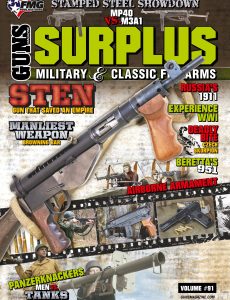
Guns Magazine – Surplus Volume 9, 2023
English | 116 pages | pdf | 55.76 MB
We tend to idolize people who can run like a gazelle, smack horsehide with wooden sticks with predictable regularity or catch an inflated pigskin one-handed while under threat of bodily annihilation. But how many of those modernday heroes could earn the Panzerknacker Mark?
Panzerknacker Marks were somewhat more challenging to obtain than championship rings or participation trophies.
To earn one, you had to destroy an enemy tank using nothing but a handheld weapon. The Tank Destruction Badge, silver, was awarded for a single tank kill. When one repeated the feat four additional times, a gold version of the Panzerknacker Mark was in order.
By 1942, the threat of Russian tanks was so great to the invading German army that they not only initiated the Panzerknacker program but also backdated it to June 1941. Desperate times indeed. By the war’s end, over 18,000 silver badges were awarded, along with nearly 400 in gold.
Before the development of weapons allowing a few dozen meters of stand-off, like the Panzerfaust and Panzerschrek, it wasn’t unusual for Panzerknacker troops to attack with axes, crowbars and a jerry can of fuel and oil. Of course, to get that close to a tank on the attack, one had to let the enemy overrun their position first — no big deal. Learn more about these men of iron, their tactics and their weapons in “The Panzerknackers: Men Against Tanks” in this issue.
Ever wondered who first fired a gun from an airplane? Or should I say aeroplane? In 1910, aviation pioneer Glenn Curtiss took off from Sheepshead Bay Race Track in Long Island, N.Y., with 27-year-old Second Lt. Jacob E. Fickel in the second seat. Fickel’s reputation as an expert marksman gained him the opportunity to please the attending crowd with a firstever air-to-ground marksmanship display. Circling the field at an altitude of about 300′, Fickel scored two bull’s-eyes out of
just four shots with his M1903 Springfield bolt-action rifle. Just two years later, Captain DeForest Chandler, Commandant of the Pilot Training School at College Park, Md., fired one of the earliest Lewis machine guns from a Type B Wright Pusher aircraft. Mounting the machine guns between his legs and resting the muzzle on a crossbar, he managed to hit a ground target five times on multiple passes. The military brass failed to see the significance of this warfare-changing moment. The General Staff made it quite clear aircraft were good for scouting and nothing else.
Sit back and enjoy this special edition of Surplus Military & Classic Firearms. From black-powder trapdoor carbines to Europe’s 1911 to the weapons of The Man from U.N.C.L.E., we’ve got the guns, and their stories, covered.
Tom MCHale Editor
Download from: